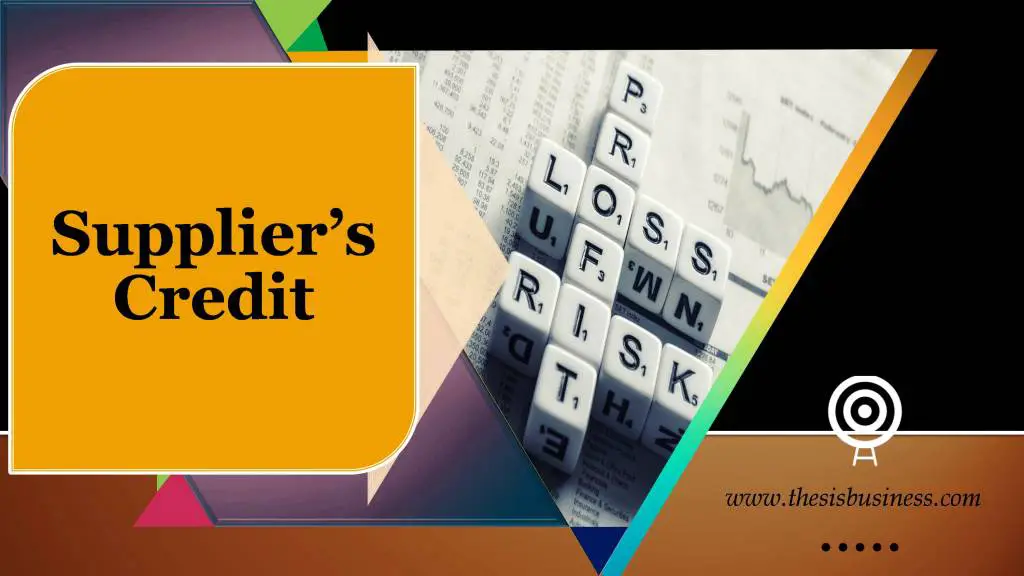In the case of high-value international transactions, there is always a requirement for a credit to promote export businesses of a country. Hence, the Trade Credit has a significant role in cross border trade/ transactions.
There are basically, two types of trade credit viz buyer’s credit & supplier credit. For detailed information about the Buyer’s credit follow the link below.
Buyer’s Credit | Meaning, Process, Pros & Cons
By the way, in this article, we will understand what the supplier credit is? And how does it work?
Table of Contents
Supplier Credit:
“Supplier Credit refers to short-term credit available to eligible buyer/ importer from the overseas banks or financial institutions for the import of permitted capital/ Non-capital goods based on Letter of Credit (LOC) under the Usance bill.”
In other words, it is a short term loan available from the recognised foreign lenders for the importers of capital/non-capital goods or services.
Sometimes, the supplier demands on-sight payment, on the other hand, the buyer requires a credit period. In this case, the exporter arranges a supplier credit for the importer of goods and thus both the buyer and supplier’s requirements are fulfilled through a supplier credit.
The foreign banks or other financial institutions provide funds to the importer at LIBOR (London Interchange Offered Rate) which is economical than other locally available loans.
The supplier credit can be provided by Overseas branches of Indian banks as well.
How does a supplier Credit work?
The proper execution of a supplier credit involves many processes which are explained step by step below.
- The first step is a sale contract between buyer and supplier for the purchase of goods or services.
- The importer, with the transaction details contacts consultant to obtain quotes for supplier Credit.
- The consultant approaches various overseas lenders such as foreign banks, foreign branches of Indian banks or other financial institutions asking for the best quotes.
- The consultant provides the best rates to the importer and if he confirms, the next step is.
- Importer approaches his local bank to open an LC and advise the supplier’s bank through overseas lenders. The supplier also receives a copy of LC through his bank.
- The supplier ships the goods and submits required documents to his banks and the supplier dispatches the same documents to the overseas lender.
- The overseas lenders check the document for discrepancies as per UCPDC 600 and forward it to the importer’s bank for confirmation.
- Upon confirmation and guarantee of payment on the due date by the importer’s bank, overseas lenders disburse the payment to the exporter using supplier credit.
- On the due date, the importer’s bank receives the total amount from the importer and remits the same to the overseas lender.
Supplier Credit – Key Benefits:
- Supplier’s Credit is a trade financing tool that avail funds to the buyers/importers of goods or services at cheaper rates by the foreign lenders.
- The interest is charged at LIBOR linked rates which is comparatively more economical than other loans.
- Supplier’s Credit is provided against Letter of Credit backed transactions only.
- The exporter gets on sight payment rather than on the due date.
- Importer gets cheaper credit rather than an upfront payment.
- Supplier’s Credit can be provided by foreign banks, foreign branches of Indian banks or other financial institutions, Export Financing Agencies (for instance, EXIM bank of India) etc.
Difference between Buyer’s Credit and Supplier’s Credit:
Though both buyer’s and supplier’s credit are trade credit which finances import of capital or non-capital goods and services, however, there are some significant differences between them.
Both buyer’s and supplier credit are issued by the overseas lenders to the buyer/ importer of goods or services, but some key differences are as follows.
- The importer applies for buyer’s credit, on the other hand, in the case of supplier credit, it is applied/ arrange by the suppliers of goods/ services.
- Buyer’s credit can be availed post shipment of goods but before the due date, whereas supplier credit can be applied before shipment of goods.
- The buyer’s credit can be utilised for any mode of payment like LC, LC Usance, DA, DP or Direct Document, on the other hand, supplier credit can be only be used with the transactions backed up by the Letter of Credit (L/C).
- The supplier credit includes many additional cost like confirmation cost, documents processing charges, LC advising fees, LC amendment etc, however, buyer’s credit doesn’t include such cost.
- The buyer’s credit has rollover facilities as well which is feasible for small importer, on the other hand, supplier credit doesn’t have such facility.
Buyer’s Credit vs Supplier’s Credit (Comparison Table):
| Parameter | Buyer’s Credit | Supplier’s Credit |
|---|---|---|
| Who applies for? | Importer/ Buyer | Exporter/ Supplier |
| When can it be applied? | Post-shipment | Pre-shipment |
| Payment Mode | LC, LC Usance, DA, DP/ Direct Documents | L/C backed transactions only |
| Additional Cost | No such costs | Confirmation cost, processing charges, LC advising fees, LC amendment |
| Rollover facility | YES | NO |
Final Words:
I hope, this article would be able to elaborate on the concept behind a supplier credit. Actually, it is the most prominent method for trade financing during cross border transaction between two parties.
The supplier credit is more suitable for high-value international transactions. As it doesn’t offer a rollover facility, therefore not feasible for small importers.

Thanks for a well explained buyer /supplier credit. It’s well understood. Please you should also include putting such notes in pdf format so that we should be able to download and refer to them at a later stage.
Thanks Mr Mponela for your valuable suggestion. We are worikng over it and shall upload pdf format for each of our articles as soon as possible.